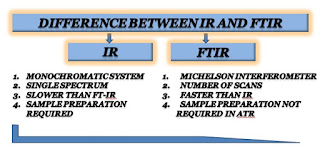The main difference between IR and FTIR is that IR uses a monochromatic system whereas FTIR uses a Michelson interferometer. Instead of shining a monochromatic beam of light onto the sample, this system shines a beam of different frequencies of light at once and determines how much of that beam is absorbed by the sample.
IR stands for Infrared Spectroscopy and FTIR stands for Fourier Transform Infrared Spectroscopy. Infrared Spectroscopy and Fourier Transform Infrared spectroscopy is spectroscopy, which is related to the infrared region of the electromagnetic spectrum, which is light with a long wavelength and a low frequency compared to visible light. It covers many techniques, which are mainly based on absorption spectroscopy. Like all spectroscopic techniques, it can be used to identify and study analytes or compounds.


IR spectroscopy is an important technique in organic chemistry. This is a simple technique to identify the presence of functional groups in a molecule. Additionally, to verify the identity of a pure compound or specific impurities, absorption can utilize the band's unique collection.
IR spectroscopy takes the absorption of a monochromatic IR light at a time and plots the spectrum, while in FTIR Multichromatic takes a rough absorption of the light and spreads it out to create a spectrum using FTIR. It is a faster and more effective technique.
Here are some points of difference between IR and FTIR.
- IR takes a single spectrum.
- FTIR uses an interferometer and performs a series of scans.
- IR used monochromatic light while FTIR used polychromatic light.
- FTIR scans up to 50 times per minute and provides better resolution.
- In FTIR, all analytes can be identified with a single measurement and interferences are resolved.
- FTIR is a faster technique than IR.
- Sample preparation in traditional IR is time consuming, whereas currently FTIR uses attenuated total reflection (ATR), so there is no need to prepare the sample.
FT-IR spectrometers are newer, have many applications and performance advantages over the dispersive instrument. The main advantages of upgrading an existing infrared instrument to FT-IR include fast analysis, high quality spectrum, reproducibility, ease of use and low maintenance.
You might also like this
Difference Between TLC and Paper Chromatography
Difference Between Normal Phase and Reversed Phase Chromatography
Difference Between IR and NMR Spectroscopy
Difference Between Isocratic and Gradient Elution
Difference Between NMR and IR Spectroscopy
Difference Between Absorption and Emission Spectrum
Difference Between NMR and IR Spectroscopy
Difference Between UV and IR Spectroscopy
Difference Between Chromatography and Spectroscopy

